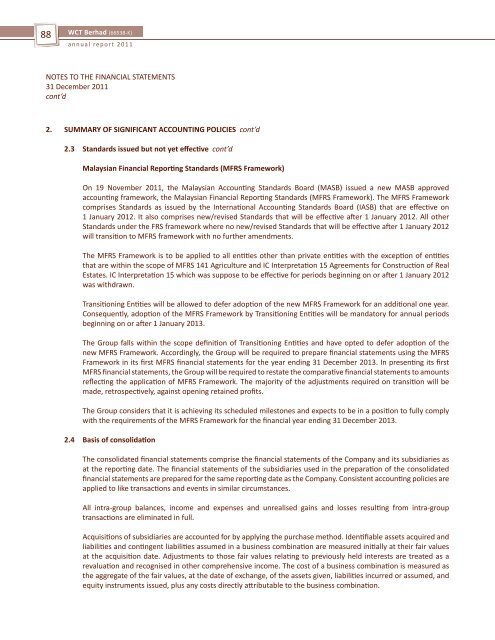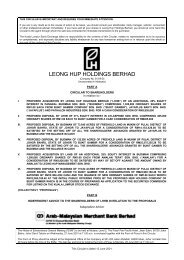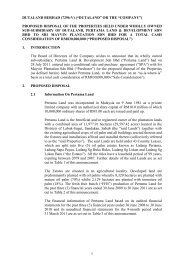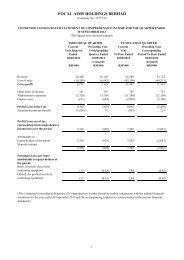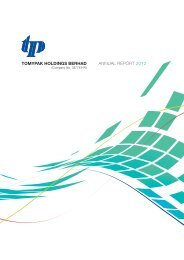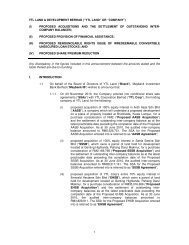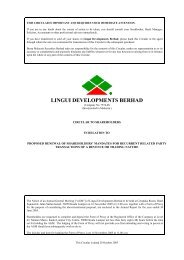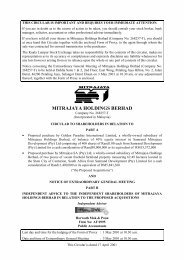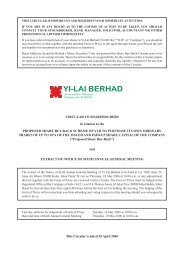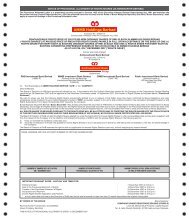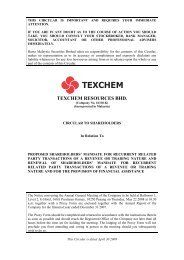WCT-Page 30 to ProxyForm (2.4MB).pdf - Announcements - Bursa ...
WCT-Page 30 to ProxyForm (2.4MB).pdf - Announcements - Bursa ...
WCT-Page 30 to ProxyForm (2.4MB).pdf - Announcements - Bursa ...
Create successful ePaper yourself
Turn your PDF publications into a flip-book with our unique Google optimized e-Paper software.
88<br />
<strong>WCT</strong> Berhad (66538-K)<br />
annual report 2011<br />
NOTES TO THE FINANCIAL STATEMENTS<br />
31 December 2011<br />
cont’d<br />
2. SUMMARY OF SIGNIFICANT ACCOUNTING POLICIES cont’d<br />
2.3 Standards issued but not yet effective cont’d<br />
Malaysian Financial Reporting Standards (MFRS Framework)<br />
On 19 November 2011, the Malaysian Accounting Standards Board (MASB) issued a new MASB approved<br />
accounting framework, the Malaysian Financial Reporting Standards (MFRS Framework). The MFRS Framework<br />
comprises Standards as issued by the International Accounting Standards Board (IASB) that are effective on<br />
1 January 2012. It also comprises new/revised Standards that will be effective after 1 January 2012. All other<br />
Standards under the FRS framework where no new/revised Standards that will be effective after 1 January 2012<br />
will transition <strong>to</strong> MFRS framework with no further amendments.<br />
The MFRS Framework is <strong>to</strong> be applied <strong>to</strong> all entities other than private entities with the exception of entities<br />
that are within the scope of MFRS 141 Agriculture and IC Interpretation 15 Agreements for Construction of Real<br />
Estates. IC Interpretation 15 which was suppose <strong>to</strong> be effective for periods beginning on or after 1 January 2012<br />
was withdrawn.<br />
Transitioning Entities will be allowed <strong>to</strong> defer adoption of the new MFRS Framework for an additional one year.<br />
Consequently, adoption of the MFRS Framework by Transitioning Entities will be manda<strong>to</strong>ry for annual periods<br />
beginning on or after 1 January 2013.<br />
The Group falls within the scope definition of Transitioning Entities and have opted <strong>to</strong> defer adoption of the<br />
new MFRS Framework. Accordingly, the Group will be required <strong>to</strong> prepare financial statements using the MFRS<br />
Framework in its first MFRS financial statements for the year ending 31 December 2013. In presenting its first<br />
MFRS financial statements, the Group will be required <strong>to</strong> restate the comparative financial statements <strong>to</strong> amounts<br />
reflecting the application of MFRS Framework. The majority of the adjustments required on transition will be<br />
made, retrospectively, against opening retained profits.<br />
The Group considers that it is achieving its scheduled miles<strong>to</strong>nes and expects <strong>to</strong> be in a position <strong>to</strong> fully comply<br />
with the requirements of the MFRS Framework for the financial year ending 31 December 2013.<br />
2.4 Basis of consolidation<br />
The consolidated financial statements comprise the financial statements of the Company and its subsidiaries as<br />
at the reporting date. The financial statements of the subsidiaries used in the preparation of the consolidated<br />
financial statements are prepared for the same reporting date as the Company. Consistent accounting policies are<br />
applied <strong>to</strong> like transactions and events in similar circumstances.<br />
All intra-group balances, income and expenses and unrealised gains and losses resulting from intra-group<br />
transactions are eliminated in full.<br />
Acquisitions of subsidiaries are accounted for by applying the purchase method. Identifiable assets acquired and<br />
liabilities and contingent liabilities assumed in a business combination are measured initially at their fair values<br />
at the acquisition date. Adjustments <strong>to</strong> those fair values relating <strong>to</strong> previously held interests are treated as a<br />
revaluation and recognised in other comprehensive income. The cost of a business combination is measured as<br />
the aggregate of the fair values, at the date of exchange, of the assets given, liabilities incurred or assumed, and<br />
equity instruments issued, plus any costs directly attributable <strong>to</strong> the business combination.


